This May in Nepal: Join the Khumjung Celebration!
If you've ever considered visiting Khumbu, the Everest region of Nepal, this May is shaping up to be a pretty good time. Of course, Namche Bazar is the main tourist hangout, and Tengboche Monastery will always be the most photogenic pit stop, but for once the spotlight will be on Khumjung, the traditional capital of Khumbu district. Tucked away in the lap of Mt. Khumbila, the sacred abobe of the region protective deity, Khumjung now has a fair share of guest houses, not to mention a bakery -- so you won't have to give up your cappuccino and chocolate croissants. But it's still, with the possible exception of Phortse, the most traditional and most beautiful village in Khumbu.
Here are three reasons to visit the Khumbu, and especially Khumjung, this May:
Reason Number One: Hillary's First Schoolhouse Turns 50
May 29 will be the Jubilee Celebration of the Khumjung Schoolhouse. Eight years after completing the first ascent of Mt. Everest, on May 29, 1953, Tenzing Norgay and Sir Edmund Hillary were arguably the most famous people in the world. Tenzing had returned to Darjeeling, India, his home since he left Nepal at the age of thirteen; a year later he became the first Field Director of the Himalayan Mountaineering Institute, which Prime Minister Jawaharlal Nehru founded specifically to capitalize on Tenzing's celebrity. Hillary, on the other hand, started building the infrastructure that allowed the Sherpas of the Khumbu district to leapfrog through several centuries of development in one generation. The first step in that surge was the opening of the one-room schoolhouse in Khumjung village in 1961. The fiftieth anniversary celebration of that watershed event, timed to coincide with the anniversary of that first Everest ascent, will be (to paraphrase Joe Biden) a Big Effing Deal.
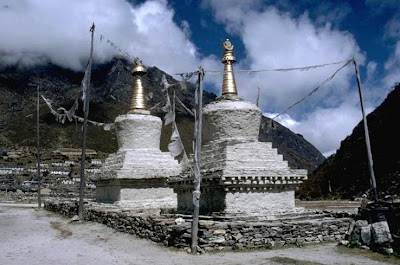
Stupas at the entry to Khumjung

Khumjung sunset
For those of you who have never taken part in a Sherpa BFD, let me assure you that these guys know how to party. There will be feasting and drinking and dancing and singing until all hours of the night, and tourists are always welcome in the celebrations. In fact, you will have to be very nimble to avoid getting dragged into their circle dances. Beware! Those dances start out reassuringly simple, but the rhythms and footwork soon get bewilderingly complex. In fact, I've always thought that the reason they're so anxious to rope us into their dances is that they find our ineptitude hilarious. Not to worry, though: just keep chugging the chang (millet beer) and you'll have a blast.
Reason Number Two: Presentation of the 2011 Hillary Medal
On May 29, in the course of the Khumjung Schoolhouse Jubilee Celebrations, we will be presenting the fifth edition of the Sir Edmund Hillary Mountain Legacy Medal. I say "we" because my wife Empar and I invented the thing back in 2003; however, the Hillary Medal has since become a lot more of a BFD than those humble origins would suggest.
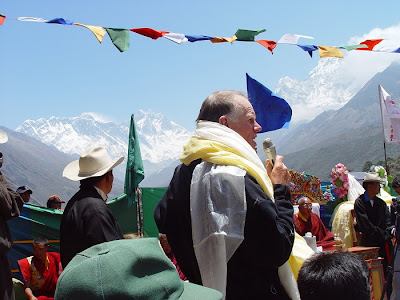
Peter Hillary at the Everest Golden Jubilee at Tengboche in 2003, venue for the presentation of the first Hillary Medal
This year the award will be going to Ang Rita Sherpa, Senior Program Manager for The Mountain Institute, one of the most important organizations in the field of mountain research, conservation and development. Ang Rita happens also to be one of the first graduates of the Khumjung School, and a good example of why Sir Edmund was right to focus on education as a means of developing economic opportunities while preserving the regions incomparable natural and cultural legacies.
The son of an illiterate farmer, born literally in a shed in Chukhung ("Little River"), which at that time was more of a place name than a village (even by Sherpa standards), Ang Rita went on from Khumjung School to complete a degree in Park Management at Lincoln University, New Zealand, and an Ms.C. in Protected Area Landscape Management from the University of Wales, UK. Since 1988, Ang Rita has been one of the more effect agents of sustainable development in the Himalayan region, developing park management protocols that have been applied as far away as Peru. He has consistently emphasized the importance of carefully-conceived trekking tourism as a means of alleviating poverty and also conserving fragile ecosystems and traditional lifestyles.
Ang Rita's selection for this year's Hillary Medal is not just a Valentines Day gift to The Mountain Institute and to Ang Rita; it is a testament to the power of Sir Edmund Hillary's vision, and to the ability of impoverished communities to take over the reins of development. The key element to economic opportunity in the Khumbu has been education, a gift first brought by grateful tourists and adventurers, starting with Ed Hillary.
For anybody interested in becoming involved in mountain ecotourism, the combined celebration of the Khumjung Schoolhouse Jubilee and the presentation of the Sir Edmund Hillary Mountain Legacy Medal to Ang Rita will be an excellent opportunity to get a close look at one of the most successful examples of protected area management as well as to meet many of the key players in mountain conservation and development.

Everest (center) and Nuptse (right), seen from Kala Pattar
Reason Number Three: The Tenzing-Hillary Everest Marathon (THEM)
This is one world-class event that you can pretty much bet will be completely dominated by Nepalis. A few Indians may turn in respectable times, but Westerners will be completely outclassed. The Sherpas will turn out en masse to watch their guys kick butt, and, even though the finish line is a half-hour downhill, the best place to watch is arguably Khumjung, where you have the longest line-of-sight as well as the most comfortable outdoor cafes -- not to mention the extravagant celebrations for the schoolhouse and Ang Rita.
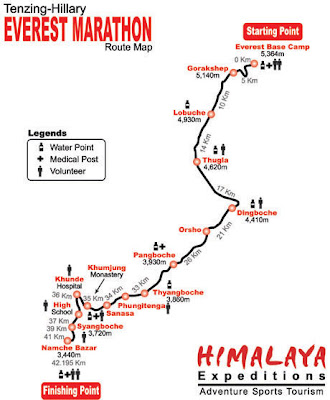
Tenzing-Hillary Everest Marathon Map & logo (courtesy of THEM Organizing
Committee)
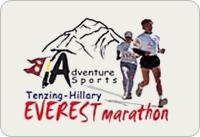
Actually, there are two different marathons that start near the base of Mt. Everest. The Everest Marathon is run in November in odd-numbered years, including 2011; it starts at Gorak Shep (5140m/16,864 ft), which is the flat dry lake bed at the foot of the Kala Pattar ridge of gorgeous Pumori. The Tenzing-Hillary Everest Marathon, on the other hand, is run on May 29 every year (to coincide with the first ascent of Everest by Tenzing Norgay and Edmund Hillary), and starts at the actual Everest Base Camp (5,364 m/17,600 ft), just below the Khumbu Ice Fall. So if you're looking for bragging rights to the world's highest marathon, the May 29 event is the one to choose.
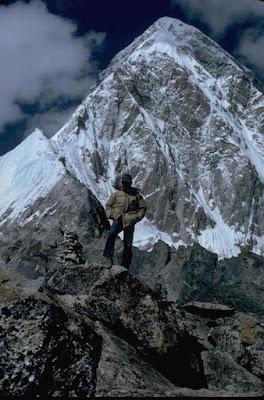
On Kala Pattar, below Pumori
Lodges at Gorak Shep

Kids on the Everest trail
Tengboche Monastery
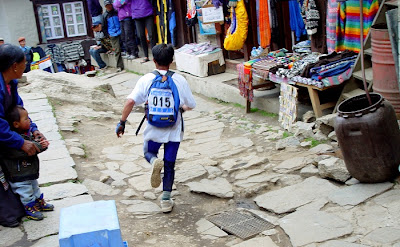
2003 Tenzing-Hillary Everest Marathon winner Uttar Kumar Rai, approaching the finish line in Namche Bazar.
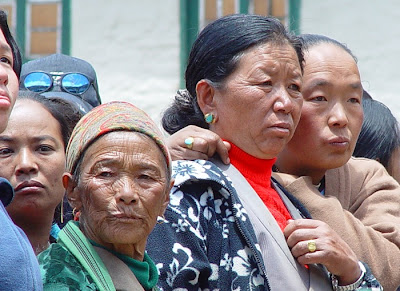
Marathon spectators
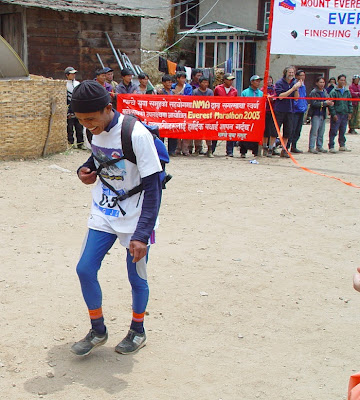
Both Everest marathons are marketed in tour packages that are a bit pricey, but not unreasonably so. For $2350, you are pretty much pampered from Kathmandu to Base Camp and back to Kathmandu. The "cheap" alternative, where you join the runners at Base Camp, is $999. That includes a couple of nights in a tent at Base Camp (useful, since the alternative is to hope you get accommodations at one of the two Gorak Shep lodges, which means a pre-dawn five-kilometer trot up the glacier to the starting point on race day) and a porter to schlep your stuff to Namche; there's also a night at Namche, and a party back in Kathmandu, plus a number of other perks.
Personally, I've never run the marathon, but I have trotted from Kala Pattar to Namche (3440 m/11286 ft) in one very long day, carrying a backpack -- and I'm hoping to do it again this May. It's not particularly hard ... if your goal is just to complete the distance, rather than to actually win the thing -- especially if someone else is carrying your pack. Some people people just walk it. Last year the median time of the 98 participants was over six hours, and the last participant came in at a leisurely 11 hours and 27 minutes. The landscape is beyond beautiful, and, provide you are well-enough acclimated to handle the altitude at the starting point, you get a definite buzz dropping almost two kilometers in one day. The oxygen level at Namche, which had you panting for breath a week before, will seem positively luxurious by the time you get back.

Tashi Tenzing, grandson of Tenzing Norgay, presents the winner's medal.
As I noted above, The Tenzing-Hillary Everest Marathon, passes through Khumjung just before diving down to Namche Bazar. At the risk of screwing up your personal best Everest Marathon time, you may want to hang out in Khumjung and enjoy the festivities awhile: once you drop down to Namche Bazar, have a few beers and air out your blistered feet, you're not going to want to climb back up to Khumjung.
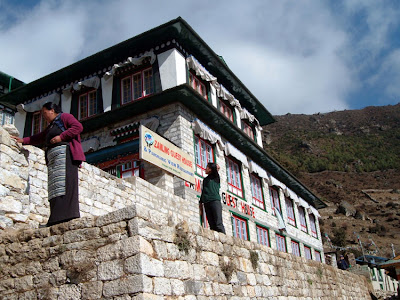
Tsedam's Zamingling Guest House, Namche's poshest digs
Okay, here are a few recommendations:
- Book now. Flights to Kathmandu fill up early.
- Book your flight through Travel de Society. Don't ask me what that name is supposed to mean. I got a round-trip JFK/KTM for $1116, including all fees and taxes. On Orbitz I would have paid around $1600.
- If you want to book a tour and skip the marathon, consider World Expeditions. They are heavily into responsible tourism, they are sponsors of the Hillary Medal, and they are utterly reliable.
- If you go on your own, which is entirely feasible, you'll find lots of great lodges in Namche Bazar. On the self-indulgent side: Tsedam's Zamling Guest House. Medium range: Ang Dorje's Namche Hotel. Budget (but still great!): Thamserku View Lodge. The proprietors of all three are extremely helpful. If, for instance, you find you need to change your Lukla-Kathmandu flight, any of them can almost certainly pull personal strings to set that up -- even if everyone else says no way.
- Bring NuSkin or another liquid blister treatment and paint your feet before they start bubbling.
- If you're tempted to spend a couple of weeks in Kathmandu, think about doing a volunteer gig with The Mountain Volunteer mountainvolunteer.org/ , a project of The Mountain Fund mountainfund.org/; they have a great home-stay program.
- Study the Visit Nepal 2011 Web site.
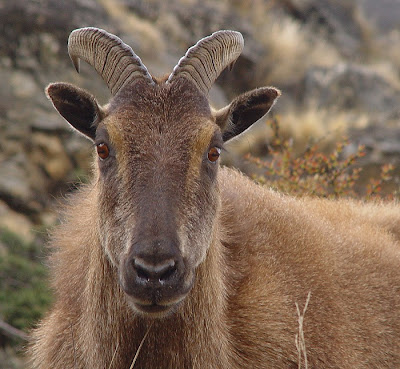
Himalayan tahr, a wild goat often seen along the trails of Khumbu
See you in Khumjung!
Seth Sicroff is the Nepal Editor for Wandering Educators
All photos courtesy and copyright Seth Sicroff, except where noted
-

- Log in to post comments



















